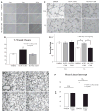Existence, functional impairment, and lung repair potential of endothelial colony-forming cells in oxygen-induced arrested alveolar growth
- PMID: 24710033
- PMCID: PMC4162516
- DOI: 10.1161/CIRCULATIONAHA.114.009124
Existence, functional impairment, and lung repair potential of endothelial colony-forming cells in oxygen-induced arrested alveolar growth
Abstract
Background: Bronchopulmonary dysplasia and emphysema are life-threatening diseases resulting from impaired alveolar development or alveolar destruction. Both conditions lack effective therapies. Angiogenic growth factors promote alveolar growth and contribute to alveolar maintenance. Endothelial colony-forming cells (ECFCs) represent a subset of circulating and resident endothelial cells capable of self-renewal and de novo vessel formation. We hypothesized that resident ECFCs exist in the developing lung, that they are impaired during arrested alveolar growth in experimental bronchopulmonary dysplasia, and that exogenous ECFCs restore disrupted alveolar growth.
Methods and results: Human fetal and neonatal rat lungs contain ECFCs with robust proliferative potential, secondary colony formation on replating, and de novo blood vessel formation in vivo when transplanted into immunodeficient mice. In contrast, human fetal lung ECFCs exposed to hyperoxia in vitro and neonatal rat ECFCs isolated from hyperoxic alveolar growth-arrested rat lungs mimicking bronchopulmonary dysplasia proliferated less, showed decreased clonogenic capacity, and formed fewer capillary-like networks. Intrajugular administration of human cord blood-derived ECFCs after established arrested alveolar growth restored lung function, alveolar and lung vascular growth, and attenuated pulmonary hypertension. Lung ECFC colony- and capillary-like network-forming capabilities were also restored. Low ECFC engraftment and the protective effect of cell-free ECFC-derived conditioned media suggest a paracrine effect. Long-term (10 months) assessment of ECFC therapy showed no adverse effects with persistent improvement in lung structure, exercise capacity, and pulmonary hypertension.
Conclusions: Impaired ECFC function may contribute to arrested alveolar growth. Cord blood-derived ECFC therapy may offer new therapeutic options for lung diseases characterized by alveolar damage.
Keywords: angiogenesis inducing agents; hypertension, pulmonary; lung diseases; stem cells.
© 2014 American Heart Association, Inc.
Figures









Comment in
-
Expanding the pool of stem cell therapy for lung growth and repair.Circulation. 2014 May 27;129(21):2091-3. doi: 10.1161/CIRCULATIONAHA.114.009727. Epub 2014 Apr 7. Circulation. 2014. PMID: 24710032 Free PMC article. No abstract available.
Similar articles
-
Endothelial colony-forming cell conditioned media promote angiogenesis in vitro and prevent pulmonary hypertension in experimental bronchopulmonary dysplasia.Am J Physiol Lung Cell Mol Physiol. 2013 Jul 1;305(1):L73-81. doi: 10.1152/ajplung.00400.2012. Epub 2013 May 10. Am J Physiol Lung Cell Mol Physiol. 2013. PMID: 23666751 Free PMC article.
-
Changes in the frequency and in vivo vessel-forming ability of rhesus monkey circulating endothelial colony-forming cells across the lifespan (birth to aged).Pediatr Res. 2012 Feb;71(2):156-61. doi: 10.1038/pr.2011.22. Epub 2011 Dec 21. Pediatr Res. 2012. PMID: 22258126 Free PMC article.
-
Endothelial colony-forming cells from preterm infants are increased and more susceptible to hyperoxia.Am J Respir Crit Care Med. 2009 Sep 1;180(5):454-61. doi: 10.1164/rccm.200901-0115OC. Epub 2009 May 29. Am J Respir Crit Care Med. 2009. PMID: 19483112 Free PMC article.
-
Pathological Roles for Endothelial Colony-Forming Cells in Neonatal and Adult Lung Disease.Am J Respir Cell Mol Biol. 2023 Jan;68(1):13-22. doi: 10.1165/rcmb.2022-0318PS. Am J Respir Cell Mol Biol. 2023. PMID: 36215049 Free PMC article. Review.
-
The vascular phenotype of BPD: new basic science insights-new precision medicine approaches.Pediatr Res. 2024 Oct;96(5):1162-1171. doi: 10.1038/s41390-022-02428-7. Epub 2022 Dec 22. Pediatr Res. 2024. PMID: 36550351 Review.
Cited by
-
Therapeutic Potential of Endothelial Colony-Forming Cells in Ischemic Disease: Strategies to Improve their Regenerative Efficacy.Int J Mol Sci. 2020 Oct 7;21(19):7406. doi: 10.3390/ijms21197406. Int J Mol Sci. 2020. PMID: 33036489 Free PMC article. Review.
-
Unique aspects of the developing lung circulation: structural development and regulation of vasomotor tone.Pulm Circ. 2016 Dec;6(4):407-425. doi: 10.1086/688890. Pulm Circ. 2016. PMID: 27942377 Free PMC article. Review.
-
Recent Advances in Endothelial Colony Forming Cells Toward Their Use in Clinical Translation.Front Med (Lausanne). 2018 Oct 23;5:295. doi: 10.3389/fmed.2018.00295. eCollection 2018. Front Med (Lausanne). 2018. PMID: 30406106 Free PMC article. Review.
-
Reshaping the Preterm Heart: Shifting Cardiac Renin-Angiotensin System Towards Cardioprotection in Rats Exposed to Neonatal High-Oxygen Stress.Hypertension. 2022 Aug;79(8):1789-1803. doi: 10.1161/HYPERTENSIONAHA.122.19115. Epub 2022 May 19. Hypertension. 2022. PMID: 35588210 Free PMC article.
-
CD34 positive cells as endothelial progenitor cells in biology and medicine.Front Cell Dev Biol. 2023 Apr 17;11:1128134. doi: 10.3389/fcell.2023.1128134. eCollection 2023. Front Cell Dev Biol. 2023. PMID: 37138792 Free PMC article. Review.
References
-
- Mourani PM, Abman SH. Pulmonary vascular disease in bronchopulmonary dysplasia: pulmonary hypertension and beyond. Curr Opin Pediatr. 2013;25:329–337. - PubMed
-
- Baraldi E, Filippone M. Chronic lung disease after premature birth. N Engl J Med. 2007;357:1946–1955. - PubMed
-
- Wong PM, Lees AN, Louw J, Lee FY, French N, Gain K, CP, Wilson A, Chambers DC. Emphysema in young adult survivors of moderate-to-severe bronchopulmonary dysplasia. Eur Respir J. 2008;32:321–328. - PubMed
Publication types
MeSH terms
Substances
Grants and funding
LinkOut - more resources
Full Text Sources
Other Literature Sources

